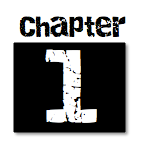 Chapter One.
Chapter One.
Probably the most rewritten chapter of any book I put together. Why do I stress so much about it? Well, it’s a make or break chapter. In those first few pages, I can either win my readers over or lose them forever. So how do we make sure our readers make it past chapter one?
Here are some of the things I’ve learned so far:
• Set the reader up with an idea of time and place. This doesn’t have to be done with screeds of description. You can hint at time with one simple sentence indicating whether it’s night or day, morning or evening, lunchtime or breakfast. Setting can be introduced with little observations that indicate where the characters might be. Are they shuffling down a stone, spiral staircase or standing on an escalator? Setting can be described through clothing, gadgets, language, architecture… there are a myriad of efficient ways to put your reader in the correct time and place without having paragraphs that describe everything from the type of trees swaying in the breeze to the colour of the paint on the walls.
• Give your readers someone to empathise with. Every human being in the world experiences emotions. There are universal fears we all face – being humiliated, rejected, abandoned, tortured, killed – just to name a few. Tapping into some of these can have the reader willing your character to succeed from the get-go. The reader will want to see how your character will overcome their particular “storm”.
• You want to be able to weave in a little background. Readers want to know about the character before the storm really hits. You have to be very delicate about the way you approach this. Backstory is really important, but it doesn’t have to all come out in that first chapter in big, chunky paragraphs. A well-crafted line of dialogue can say so much, so can a character’s micro-expressions, the way they move and dress and their thought patterns. Little pieces of information dropped within the action is an entertaining way of getting to know the character… and it also builds the mystery, which is my next point.
• Your first chapter MUST have a little mystery. It doesn’t matter what genre you are writing in, you have to hint at something that will compel your readers to find out more.
• And speaking of genre, you need to have a clear idea of what genre you’re writing in before you start. I say this because it’s important to set the tone in this first chapter as well. Your reader wants to know if they’re launching into a hip contemporary YA book filled with teen speak or a dark murder mystery or a political thriller or a nostalgic memoir. Admittedly they should pick this up from the book description, so don’t throw them for a loop by suddenly changing the voice and tone of the text.
* I have gleaned these ideas from many great writing books, but one in particular that laid it out in a very straight-forward, easy manner was Writing Great Books for Young Adults by Regina Brooks. (Link: books only available in paperback, but I thought I’d include the link anyway. http://www.amazon.com/Writing-Great-Books-Young-Adults/dp/1402226616/ref=sr_1_3?s=books&ie=UTF8&qid=1354333796&sr=1-3&keywords=Regina+Brooks)
** Another thing I would advise is to go through all your “top reads” and see what the authors have done in their first few chapters. What compelled you to keep reading? Analysing other people’s work is an excellent way to learn.

According to science fiction author Alan Wold, you really only have the first 100 words to snag a reader. If you still have their attention at the end of the first chapter, you’re doing really well. 🙂
Good advice — thanks, Melissa!
Wonderful advice, Melissa!
I know about snagging readers right away, in my first book, I proabably rewrote chapter one a dozen times before I was some what happy with it! This is harder than actually writing the book! Thanks for the advice!
Great advice. Made me do a mental checklist on mine. It is so important to make that first chapter a good hook.
In days gone by stories started slower, working up to a mini crescendo, before teasing out and then building again slowly; depending on any number of things of course: style, setting, genre et cetera, but I’m talking generally, and that was true of movies too.
Now, however, without that hook the fish is gone. It seems to be, regardless of genre, hit the ground running! Some things don’t change though, by hook or by crook, you better know your craft.
Nice article, Melissa.
Spot on advice Melissa. It’s become increasingly important to grab the reader’s attention within the first few paragraphs and certainly the first chapter. I too spend more time faffing about with chapter one.
On my latest book I wrote out the bare bones of chapter one, wrote the rest of the book and then wrote chapter one. That worked for me.
Sorry for my slow response to all these lovely comments. I’ve been away from the internet for the last few days.
Thanks for everyone’s thoughts… and good luck with all your first chapters!! 🙂